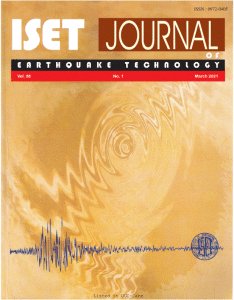Home > Issues & Journals
Probabilistic seismic hazard mapping of northwest india using area sources with non-uniform spatial distribution of seismicity
A.K. Jaisal, Ishwer D. Gupta and Vinay K. Gupta
Paper No.: 556
|
Vol.: 57
|
No.: 3
|
September, 2020
|
pp. 103-150

Abstract
The northwest region of India is prone to very high level of seismic hazard due to the presence of the western Himalayan plate boundary within the region. To manage and mitigate the associated risk in an effective manner, it is necessary to have reliable and realistic mapping of seismic hazard in the region. This study presents a comprehensive seismic hazard analysis to prepare the probabilistic seismic hazard maps of northwest India in terms of 5%-damping spectral accelerations at different natural periods for rock-type site conditions in a significant updating of the results of the previous studies. Major improvements made in the present study include: use of non-uniform spatial distribution of the expected seismicity over each of the 16 area sources of shallow crustal earthquakes considered, consideration of the additional effect of deep focus earthquakes in Hindukush subduction zone by modeling this as a dipping plane source, selection of the most appropriate ground motion prediction equations (GMPEs) for both types of seismic sources by using the available strong motion data, and estimation of the source-to-site distance metrics consistent with the selected GMPEs. An empirical approach, based on a detailed seismic hazard analysis for different soil conditions, is also proposed to obtain realistic amplification factors for modifying uniform hazard response spectra for the rock sites to those for the soil sites with a given value. A critical comparison of the results of this study with those of the major past studies indicates large discrepancies and differences, which could be attributed to several unrealistic and subjective assumptions and idealizations made in the past studies. Finally, on comparing the present estimates with those prescribed by the Indian code IS 1893 (Part-1), it is found that one additional zone of greater hazard level may need to be introduced in the code. A simple modification involving the MCE-level hazard estimates for peak ground acceleration and 0.2-s spectral acceleration is also proposed in the Type-I spectral shape prescribed by the Indian code in order to raise the hazard levels for non-rigid structures.
Keywords: Probabilistic Seismic Hazard; Northwest Himalayan Region of India; Seismic Sources; Ground Motion Prediction Equation (GMPE); Uniform Hazard Response Spectra; Site Amplification; Hindukush Subduction Zone
©2025. ISET. All Rights Reserved.